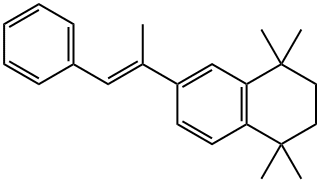替马罗汀 用途与合成方法
Modulation of ornithine decarboxylase (ODC) gene expression by retinoids is analyzed in human keratinocyte cultures maintained in serum-free medium containing 0.15 mM Ca 2+ . Cells are incubated with all-trans-retinoic acid, 13-cis-retinoic acid or arotinoid Ro15-0778 (0.1 nM to 10 μM), total RNA is isolated, and mRNA transcripts for ODC are analyzed by Northern and slot blot hybridizations with a human ODC cDNA. Treatment of cells for 24 h results in a dose-dependent decrease in ODC mRNA levels, with an estimated IC 50 of approximately 10 nM for all-trans- and 13-cis-retinoic acid, while Ro15-0778 is somewhat less effective (IC 50 approximately 0.1-0.5 μM). The suppression of ODC mRNA levels by retinoids is detectable at approximately 3 h of incubation, with essentially a maximal inhibition at 12 h. Reduced ODC mRNA levels noted after 24 h of incubation with 0.5 μM all-trans-retinoic acid are accompanied by a reduction in ODC enzyme activity.
The aim of this preliminary report is to measure plasma and skin concentrations of Ro 15-0778 and its phenolic metabolite Ro 14-6113 in hairless rats receiving orally 10 mg/kg of Temarotene once daily during 10 days. Blood (2-3 mL) and skin (200-300 mg) samples are taken at different time points between 0.5 and 240 h after the last dose. A highly sensitive HPLC method is used for simultaneous determination of the two compounds with a quantification limit of 2 ng/mL in plasma and 10 ng/g in total skin (epidermis and dermis). After 10 h, plasma concentrations of Ro 14-6113 are 5-13 times higher than for Ro 15-0778. Ro 14-6113 concentrations in the skin are 4-10 times higher than for Ro 15-0778 within the initial 48 h. The concentrations of both compounds in the skin are higher than concentrations in plasma.


